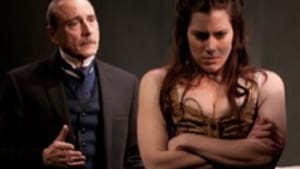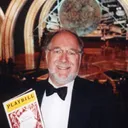Stay in the Loop
BSR publishes on a weekly schedule, with an email newsletter every Wednesday and Thursday morning. There’s no paywall, and subscribing is always free.
Ibsen's confession (or is it?)
Ibsen’s “Master Builder” at People’s Light (1st review)

With its layers of ambiguity, Ibsen's The Master Builder wasn't well received at its 1892 premiere and is infrequently performed in our time. The plot can be confusing and the lead characters could seem cartoonish.
A recent translation from Norwegian into English by Paul Walsh is straightforward and easy to follow. This script was first heard at Yale Repertory Theatre in 2009, but that production suffered from a surreal modernistic set. People's Light, by contrast, uses a simple set with chairs, sofas, desks, lamps and a coat rack that look authentically 1890s, and the modern-sounding dialogue seems to fit right in to the period setting.
The story concerns Halvard Solness, an egocentric and controlling designer and builder of homes and churches. He has used people and discarded them, and he has exploited tragic circumstances to become rich. Now nearing 60, he hasn't discarded his attractive wife, but he treats her coldly and has become involved with Kaja, his attractive young bookkeeper (Jessica Bedford).
Halvard's designs on Kaja may not be strictly romantic. She's engaged to Halvard's young employee Ragnar (Ross Beschler), the creator of most of the firm's architectural drawings. Halvard worries that this talented young man will open his own office and usurp Halvard's prominence as the country's "master builder."
Is Halvard really attracted to Kaja, or is he just using her as tool to keep Ragnar as an employee? The ambiguities begin to beguile us. Kaja clearly is smitten with Halvard. But are Halvard and Kaja actually sleeping together? Halvard's wife evidently thinks so.
Another younger woman
Into this triangle (or is it a rectangle?) enters another young woman. Hilda (Kim Carson), intense and physically attractive, breezes into the office to remind the master builder that they met ten years earlier, when she was just 13. Halvard seems not to remember this meeting, and he's shocked when Hilda recounts how Halvard grabbed and repeatedly kissed her when they were alone in her parents' home.
Is the builder having a senior moment of forgetfulness, or has he willfully blocked from memory his conduct? Or is Hilda making this story up?
Things get even more intriguing when the self-centered Halvard muses that perhaps he had lustful thoughts about the child and the power of his mind caused her to think that he actually acted on those thoughts. Was it his wishful thinking, or hers?
Hilda moves into Halvard's home and brashly takes charge of his life. She is a magnetic force and electricity crackles between the two of them. She inspires him to new creative heights, but, like Lorelei, leads him towards his doom.
Ibsen's open affair
This story directly parallels Ibsen's own life. At age 63 Ibsen had an open affair with Hildur Andersen, a 27-year-old concert pianist, while his wife wintered in Italy. Like the fictitious Hilda, Hildur was the daughter of family friends, and Ibsen met her when she was only ten. While he wrote The Master Builder, Ibsen also had a fling with an 18-year-old Viennese student at a mountain resort.
Yet the play, of course, ultimately diverges from real life. Ibsen, the master playwright, went far beyond this opening set-up.
Novelli's new take
Stephen Novelli masterfully underplays Halvard's selfishness and megalomania and causes us to identify instead with Halvard's insecurities. Kim Carson as Hilda is his perfect foil, tempting and incendiary, a life force who could invigorate any aging man.
Susan McKey puts up with her position as the neglected wife through most of the play. Only in the final scenes does Ibsen allow her to show her underlying love for Halvard, and McKey is touching in those moments.
The family doctor and confidante was played by Mark Lazar, who also portrayed an avuncular doctor (Watson) in Peoples Light's recent The Secret of Sherlock Holmes. When Halvard describes his dilemmas, the doctor is as skeptical as you or I would be. He thus becomes a surrogate for the audience. His humorous ripostes are a highlight of the evening.
To convey the unspoken feelings of the characters, Daniel Vatsky has produced videos that are projected on all the walls of the set from time to time. It's a good idea, suggesting that more is going on that what we hear spoken, but the actual content— swirling underbrush and falling leaves— is innocuous.♦
To read another review by Steve Cohen, click here.
A recent translation from Norwegian into English by Paul Walsh is straightforward and easy to follow. This script was first heard at Yale Repertory Theatre in 2009, but that production suffered from a surreal modernistic set. People's Light, by contrast, uses a simple set with chairs, sofas, desks, lamps and a coat rack that look authentically 1890s, and the modern-sounding dialogue seems to fit right in to the period setting.
The story concerns Halvard Solness, an egocentric and controlling designer and builder of homes and churches. He has used people and discarded them, and he has exploited tragic circumstances to become rich. Now nearing 60, he hasn't discarded his attractive wife, but he treats her coldly and has become involved with Kaja, his attractive young bookkeeper (Jessica Bedford).
Halvard's designs on Kaja may not be strictly romantic. She's engaged to Halvard's young employee Ragnar (Ross Beschler), the creator of most of the firm's architectural drawings. Halvard worries that this talented young man will open his own office and usurp Halvard's prominence as the country's "master builder."
Is Halvard really attracted to Kaja, or is he just using her as tool to keep Ragnar as an employee? The ambiguities begin to beguile us. Kaja clearly is smitten with Halvard. But are Halvard and Kaja actually sleeping together? Halvard's wife evidently thinks so.
Another younger woman
Into this triangle (or is it a rectangle?) enters another young woman. Hilda (Kim Carson), intense and physically attractive, breezes into the office to remind the master builder that they met ten years earlier, when she was just 13. Halvard seems not to remember this meeting, and he's shocked when Hilda recounts how Halvard grabbed and repeatedly kissed her when they were alone in her parents' home.
Is the builder having a senior moment of forgetfulness, or has he willfully blocked from memory his conduct? Or is Hilda making this story up?
Things get even more intriguing when the self-centered Halvard muses that perhaps he had lustful thoughts about the child and the power of his mind caused her to think that he actually acted on those thoughts. Was it his wishful thinking, or hers?
Hilda moves into Halvard's home and brashly takes charge of his life. She is a magnetic force and electricity crackles between the two of them. She inspires him to new creative heights, but, like Lorelei, leads him towards his doom.
Ibsen's open affair
This story directly parallels Ibsen's own life. At age 63 Ibsen had an open affair with Hildur Andersen, a 27-year-old concert pianist, while his wife wintered in Italy. Like the fictitious Hilda, Hildur was the daughter of family friends, and Ibsen met her when she was only ten. While he wrote The Master Builder, Ibsen also had a fling with an 18-year-old Viennese student at a mountain resort.
Yet the play, of course, ultimately diverges from real life. Ibsen, the master playwright, went far beyond this opening set-up.
Novelli's new take
Stephen Novelli masterfully underplays Halvard's selfishness and megalomania and causes us to identify instead with Halvard's insecurities. Kim Carson as Hilda is his perfect foil, tempting and incendiary, a life force who could invigorate any aging man.
Susan McKey puts up with her position as the neglected wife through most of the play. Only in the final scenes does Ibsen allow her to show her underlying love for Halvard, and McKey is touching in those moments.
The family doctor and confidante was played by Mark Lazar, who also portrayed an avuncular doctor (Watson) in Peoples Light's recent The Secret of Sherlock Holmes. When Halvard describes his dilemmas, the doctor is as skeptical as you or I would be. He thus becomes a surrogate for the audience. His humorous ripostes are a highlight of the evening.
To convey the unspoken feelings of the characters, Daniel Vatsky has produced videos that are projected on all the walls of the set from time to time. It's a good idea, suggesting that more is going on that what we hear spoken, but the actual content— swirling underbrush and falling leaves— is innocuous.♦
To read another review by Steve Cohen, click here.
What, When, Where
The Master Builder. By Henrik Ibsen; translation by Paul Walsh; Ken Marini directed. Through April 17, 2011 at Peoples Light & Theatre, 39 Conestoga Rd., Malvern, Pa. (610) 644-3500 or peopleslight.org.
Sign up for our newsletter
All of the week's new articles, all in one place. Sign up for the free weekly BSR newsletters, and don't miss a conversation.

 Steve Cohen
Steve Cohen